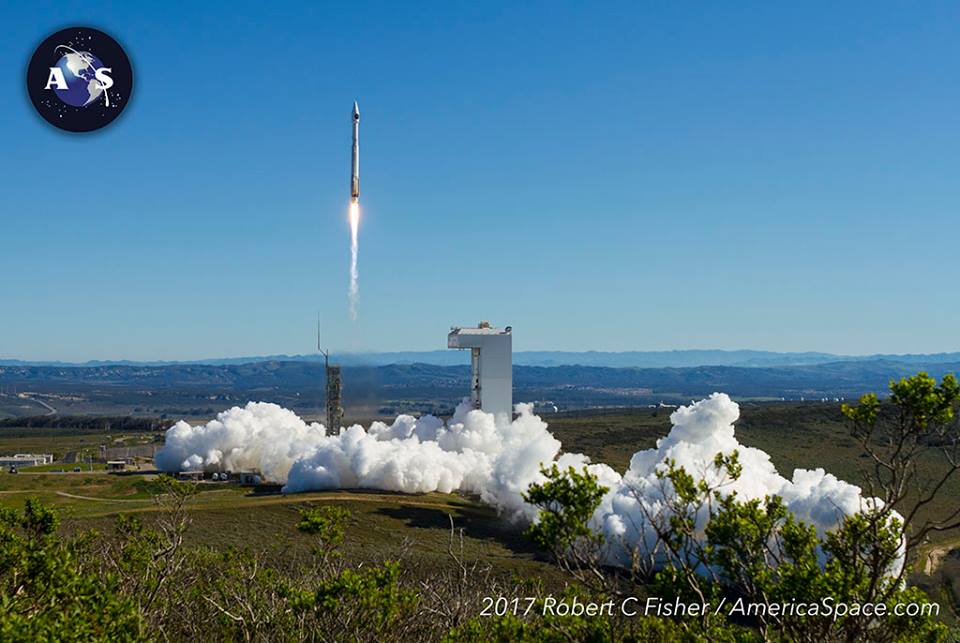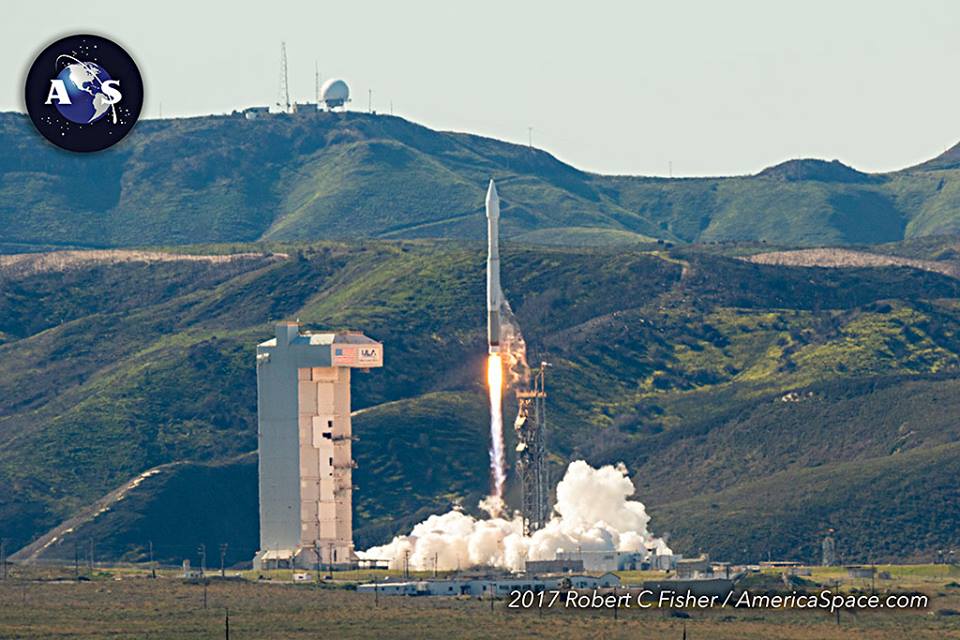
United Launch Alliance (ULA) kicked off a busy month of flights today with the apparent successful launch from Vandenberg AFB, Calif. of the National Reconnaissance Office NRO 79 mission with two top secret Intruder ocean surveillance satellites on board an Atlas-V 401 rocket.
Liftoff into clear skies from Vandenberg’s SLC-3 East came at 9:49:51 a.m PST (12:49:51 p.m. EST), in the midst of a 1 hour launch period that ran from 9:30 – 10:30 a.m. PST.

The flight marked the 70th ULA Atlas-V launch and the 35th in the 401 configuration with no solid boosters, but a 4 meter (13 ft.) diameter fairing. It is the first Intruder mission since Oct. 8, 2015.
“I am so impressed by the incredible teamwork between the NRO, U.S. Air Force, our industry partners and the ULA team that resulted in today’s successful launch. The integrated mission team overcame many challenges, including delays associated with the Vandenberg Canyon Fire last year,” said Laura Maginnis, vice president, Government Satellite Launch.
“Tragically, Ventura County firefighter Ryan Osler lost his life en route to assist in fighting the fire. We are honored to dedicate today’s mission to Ralph and his family. Thank you to all of the men and women who worked to deliver this critical asset for our nation’s security.”
NRO 79’s Atlas-V 401, with an 860,000 lb. thrust Russian Energomash RD-180 oxygen/kerosene engine, passed Mach 1 at 80 seconds into flight, taking a southern trajectory skirting west of Los Angeles at 50 mi. altitude then down along the Pacific coast of California and Baja Mexico, past Central America and rounding out at 63.4 deg. latitude just north of Antarctica early in its first orbit.
Given the secret nature of the mission, the only ascent milestones specifically called out publicly were the RD-180 cutoff at 4 min. 3 sec.,first stage separation at 4 min. 9 sec. and ignition of the Aerojet Rocketdyne Centaur upper stage at 4 min. 19 seconds.
The Atlas nose shroud separation occurred at 4 min 31 sec. into the flight, with the first Aerojet Rocketdyne Centaur cutoff at 15 min. 22 sec.
The vehicle should have then coasted for about 10 minutes, before the second 25,000 lb. thrust Centaur RL10C-1 engine burn at 25 minutes into flight, with cutoff around 28 min.
Once Centaur upper stage maneuvers were complete, along with measures to confuse adversaries on the exact position of the satellites, they were separated in their planned 1,000 x 1,200 km. (621 x 745 mi.) orbits inclined 63.4 degrees.
“National security is imperative to the safe and secure future of our country and its citizens,” said Aerojet Rocketdyne CEO and President Eileen Drake. “It’s truly gratifying to know that the propulsion systems our employees build here at Aerojet Rocketdyne are helping to keep this country – and the brave military men and women protecting it overseas – safe from harm. Congratulations to all on another successful launch.”
The spacecraft and launch patches for NRO-79 featured the Greek goddess Athena, known for fighting just wars. Armed with a sword and shield she featured an owl-eyed eye patch denoting wisdom.

The month of March will involve three ULA launches, including today’s mission from Vandenberg, and Atlas V and Delta IV flights coming up from the Cape.
If they hold to schedule, all of the flights are to take place during the first 19 days of March.
The remaining missions are:
- March 8: Delta-IV Medium 5,4 rocket will launch the 9th Wideband Global Satcom (WGS-9) into geosynchronous orbit from Cape Canaveral’s Launch Complex 37 during a launch window that runs from 6:48 p.m. to 7:53 p.m. EST.
- March 19: An Atlas-V 401 rocket is to launch the Orbital ATK OA-7 Cygnus cargo delivery to the International Space Station for NASA, with liftoff between 10:56 p.m. and 11:26 pm. EST.
As always, AmericaSpace will provide in-depth reporting leading up to, and following, both launches, with our on-site team & LIVE COVERAGE on launch day.
.
Be sure to “LIKE” AmericaSpace on Facebook and follow us on Instagram & Twitter!
.
Missions » NROL » Missions » NROL » NROL-79 »




